221988
Ammonium thiocyanate
ACS reagent, ≥97.5%
Sinónimos:
Ammonium rhodanide
About This Item
Productos recomendados
grado
ACS reagent
Nivel de calidad
Análisis
≥97.5%
formulario
crystals
impurezas
≤0.004 meq/g I2 consumers
≤0.005% insolubles
residuo de ign.
≤0.025%
pH
4.5-6.0 (25 °C, 5% in H2O)
mp
152-154 °C (lit.)
trazas de anión
chloride (Cl-): ≤0.005%
sulfate (SO42-): ≤0.005%
trazas de catión
Fe: ≤3 ppm
heavy metals (as Pb): ≤5 ppm
cadena SMILES
N.SC#N
InChI
1S/CHNS.H3N/c2-1-3;/h3H;1H3
Clave InChI
SOIFLUNRINLCBN-UHFFFAOYSA-N
¿Está buscando productos similares? Visita Guía de comparación de productos
Descripción general
Aplicación
- Substituted 2-aminothiazole derivatives by reacting with -halo ketone carbonyls in the presence of N-methylimidazole.5
- Thiiranes from corresponding oxiranes in the presence of lithium tetrafluoroborate.
Palabra de señalización
Danger
Frases de peligro
Clasificaciones de peligro
Acute Tox. 4 Dermal - Acute Tox. 4 Inhalation - Acute Tox. 4 Oral - Aquatic Chronic 3 - Eye Dam. 1
Riesgos supl.
Código de clase de almacenamiento
13 - Non Combustible Solids
Clase de riesgo para el agua (WGK)
WGK 1
Punto de inflamabilidad (°F)
Not applicable
Punto de inflamabilidad (°C)
Not applicable
Certificados de análisis (COA)
Busque Certificados de análisis (COA) introduciendo el número de lote del producto. Los números de lote se encuentran en la etiqueta del producto después de las palabras «Lot» o «Batch»
¿Ya tiene este producto?
Encuentre la documentación para los productos que ha comprado recientemente en la Biblioteca de documentos.
Los clientes también vieron
Nuestro equipo de científicos tiene experiencia en todas las áreas de investigación: Ciencias de la vida, Ciencia de los materiales, Síntesis química, Cromatografía, Analítica y muchas otras.
Póngase en contacto con el Servicio técnico











